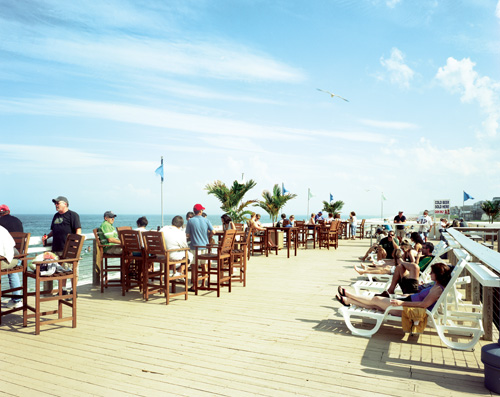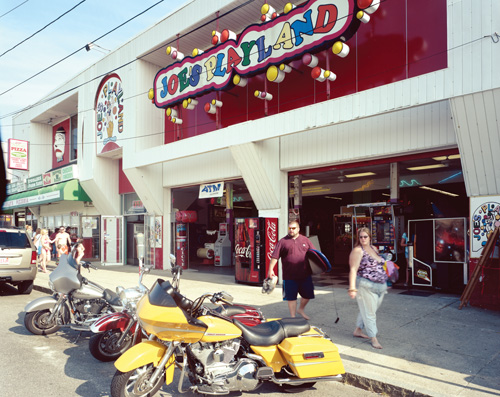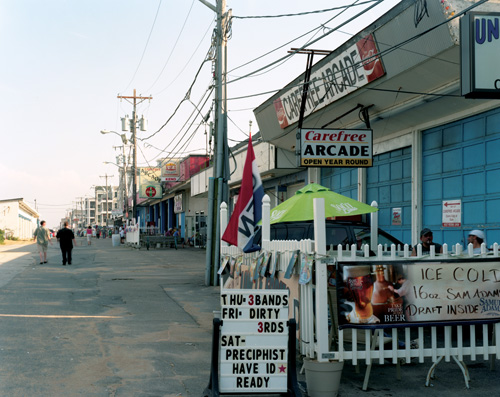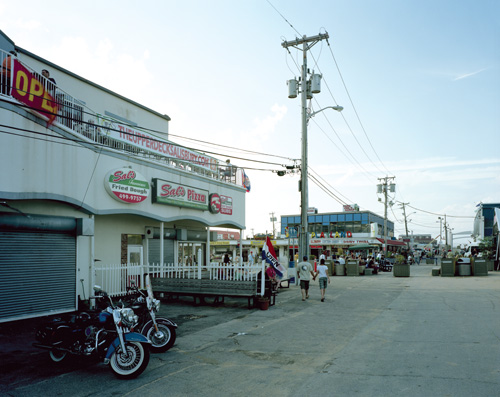What was once a destination for couples and families, Salisbury has become a town in search of a future. But new high-end developments and a strong push to bring visitors back could change all of that. By Bryan McGonigle. Photographs by David Lier.
Moments after enduring a light rain to see the Tall Ships at the Salisbury Beach State Reservation, Julie Carney of Worcester walks along Salisbury Beach, looking at the few renovated buildings scattered among some boarded-up and run-down properties. As the sun breaks through the clouds and she makes her way to the beach center, the occasional smell of trash piercing the saltwater air gives way to the aroma of pizza mixed with grilled gourmet food from a seaside restaurant.
“This beach has a lot of potential,” she says. “I don’t know why they wouldn’t have renovated the whole place before.”
Elsewhere in town, Salisbury resident Ray Champagne muses on the recent influx of visitors. As the president of the Salisbury Beach Betterment Association-a group that locals formed in the 1980s to promote a better image of the beach-he’s pleased that redevelopment plans are finally coming to life and bringing people back to the beach slowly, but surely.
“I think the merchants are excited that there seems to be a new image being promoted,” he says. “Salisbury Beach is coming back.”
The negative image washing over the nostalgic memories of grandeur and crashing against hopes of future prosperity presents a unique challenge to Salisbury Beach. Once a jewel of the Northeast that has virtually slipped into oblivion, Salisbury is trying to overcome an era of dilapidation and low reputation through a massive revitalization effort years in the making.
 Salisbury has a long history of drawing crowds from all over since the 19th century. Railroad development, growing industrial wealth, and the emergence of the middle class transformed this salt marsh plantation and shipbuilding community into a place of leisure, beckoning the tired, the bored, and the carefree to its miles of unbroken beaches. By the birth of the 20th century, tourism and recreation were the foundation of the town’s economy.
Salisbury has a long history of drawing crowds from all over since the 19th century. Railroad development, growing industrial wealth, and the emergence of the middle class transformed this salt marsh plantation and shipbuilding community into a place of leisure, beckoning the tired, the bored, and the carefree to its miles of unbroken beaches. By the birth of the 20th century, tourism and recreation were the foundation of the town’s economy.
In the 1940s and 1950s, crowds of well-dressed men and women gathered at The Frolics nightclub to dance with an intoxicating combination of salty air, beach moonlight, and music sung by Frank Sinatra, Louis Armstrong, and Frankie Avalon. In the 1970s, The Frolics would feel the electrifying rock of a young band called Aerosmith.
While adults sipped their drinks and listened to the greats, the children enthusiastically engaged themselves on the many rides at the beach center. The Dodgem, the original bumper car, made its debut at Salisbury Beach in 1920 after Max Stoehrer of Methuen created it to capitalize on the excitement of the automobile and give average people the feeling of driving one. For decades, thrill-seekers waited in line to be whipped around on the Sky Rocket, the Comet, and the Himalaya, while others walked along the miles of uninterrupted shore as the sounds of carousel music and roaring crowds mingled in the summer air.
But by the 1990s, the tide had turned in an unfavorable direction. Development stalled, property values declined, and revenues sank.
“The town was not in good financial shape, and in fact, went several years with zero free cash or even negative free cash because it was in a deficit,” says Town Manager Neil Harrington. Eventually, Salisbury was put on a Massachusetts Department of Revenue watch list and could not set its tax rate until the state had verified all of the financial closeout figures for the end of the fiscal year. The town laid off half the police department in 2002. The library was shuttered, the town hall was closed two days a week, and curbside trash pickup ceased. Property values began diving and property tax revenues were depleted.
On the commercial front, development of the beach experienced dragged as well. Interest rates had soared in the 1970s and 1980s, slowing development. Properties later deteriorated. The town had a relatively low property tax rate, but competition from Hampton Beach coupled with the town’s management troubles may have dampened enthusiasm to build at Salisbury Beach.
In the mid-1990s, Harveys Casino Resorts of Nevada announced a plan to build a $300 million complex at Salisbury Beach that would span 20 acres and include a casino, resort, amusement park, and more. It promised to create more than 4,000 jobs and generate millions of dollars in tax revenue. But the casino was stalled by opposition from residents, as well as debate in the state legislature over legalizing casino gambling in Massachusetts.
“A lot of the beachfront commercial area kind of hit a stagnant point,” Champagne says. “Nobody wanted to do any improvements in the residential areas because people were afraid they would be destroyed [to make way for the casino]. And that continued for many years while the beach commercial district had no real direction.”
In May of 2000, after half a decade of debate over bringing casino gaming to Salisbury, town voters decisively rejected the casino plans, and the State House refused to allow casino gaming. Harveys gave up on its land options and headed back to Nevada, as The Frolics nightclub rotted and was eventually bulldozed away. The amusement park closed shortly afterward, and the beach became a virtual ghost town, with the roar of crowds and music merely memories in the ocean breeze.
In 2002, the town hired Harrington, the former Salem mayor, Â as town manager. He reorganized the town’s management structure and created a finance director position. “We instilled some fiscal discipline and got the town back on a positive financial footing.” Harrington says.
After the Harveys casino deal fell through, the town rezoned the beach area, adding drive-through businesses, auto sales and repair shops, car washes, and chemical warehouses to the list of businesses not welcome at the beach. Real estate developers believed people would be more inclined to invest in properties now that the threat of casino gaming was gone.
But the town couldn’t seem to come up with a cohesive plan for the beach. New hope came with the help of a local engineer, Wayne Capolupo, owner of SPS New England, a construction company headquartered in Salisbury that has dealt mostly with bridge building. Capolupo has set his sights on the shoreline to develop real estate and revitalize the beach center.
“I’ve lived in the town my whole adult life, so this is something I’ve been thinking about for a long time,” Capolupo says of the plans. “A number of different parties all came together at the same time, and everybody agreed that the time was right.”
There have been obstacles to the revitalization, however. The permitting process, although made more efficient in recent years, is still complicated when building on a beach. Capolupo said SPS New England has been proactive about protecting the beach’s resources to ease that process. A less controllable obstacle-and the one that has caused such a lengthy timeframe for the total project-has been the economy.
“The economic collapse that hit last fall put a total delay on redevelopment on the beach,” Capolupo says. “The residential real estate market is in a terrible slump, but even the commercial market is in a downturn.”
Salisbury has long suffered with an image problem. It’s become known as a memory of what the beach used to offer. Concerts, rides, and family fun have been replaced by Ten’s Showclub, the famous strip club on North End Boulevard, as the town’s main attraction in recent years. That image is one that Capolupo and the town hope to change with their revitalization plan.
 In the past three years, SPS New England has built and opened two year-round restaurants and a deck bar. People can enjoy a gourmet Italian meal at Capri Seaside Italian Grille, or they can walk over to the shoreline and dine at Seaglass, a restaurant located in the revamped New Pavilion with a green, healthy theme, upscale decor, and seating overlooking the water. Next door, in the spot where the 5 O’Clock nightclub once stood, is SurfSide5, a seaside bar complete with an 8,000-square-foot deck and live bands, also owned and operated by Capolupo. Business has been great, and the reception from the beach community has been overwhelming, Capolupo says.
In the past three years, SPS New England has built and opened two year-round restaurants and a deck bar. People can enjoy a gourmet Italian meal at Capri Seaside Italian Grille, or they can walk over to the shoreline and dine at Seaglass, a restaurant located in the revamped New Pavilion with a green, healthy theme, upscale decor, and seating overlooking the water. Next door, in the spot where the 5 O’Clock nightclub once stood, is SurfSide5, a seaside bar complete with an 8,000-square-foot deck and live bands, also owned and operated by Capolupo. Business has been great, and the reception from the beach community has been overwhelming, Capolupo says.
Capolupo intends to keep and manage those businesses, not sell them. He recently purchased the land on which they stand for $7.2 million, making it the largest single real estate sale in Salisbury’s recent history-and the largest regionally since real estate developer Stephen Karp’s $38 million purchase of Newburyport waterfront and downtown properties four years ago.
Meanwhile, SPS New England and the Salisbury Beach Partnership, a non-profit group created by Salisbury business leaders in 2007, have been organizing events to draw crowds to the beach and change the way people think of Salisbury. There are fireworks every Saturday night, the Maritime Festival, the Sand and Sea Festival, and more. The Partnership helped bring the Tall Ships to the beach in the summer and is working with the Blue Ocean Society, a non-profit marine education group, to organize beach cleanups and run a marine education center in the beach center. The focus is on economical fun.
Champagne owns Beach Rose RV Park in Salisbury and says business has been steadily increasing in recent years. With a lot of his business coming from Europeans and traveling retirees visiting the North Shore for the first time, he feels having the beach revitalized will give his customers a better first impression of the North Shore and Salisbury than the one they were getting in years past.
“I want to see my investment prosper, and so when the merchants promote a better beach for tourism, it’s better not just for me, but for the whole community,” Champagne says. “If they come into Salisbury as a primary stay on their vacation, it’s always great to have a positive image.”
While Capolupo and the Partnership work on the commercial properties of the center, most of the residential renovation at the beach is being handled by Boston real estate developer Thompson Design Group. In 2007, the company, which is well known for its renovation of Quincy Market, began negotiating partnership agreements with property owners at the beach to create a uniform style along the shore with a grandeur not seen in decades. The overall plan of the project is to secure the property agreements and then raze the area and rebuild with a universal architectural theme.
One person who didn’t wait for the redevelopment and who wasn’t turned away by the beach’s poor image was former Boston Bruin Terry O’Reilly. In 2000, as the casino debate was still lingering, O’Reilly bought the former Edwards Hotel on the corner of Atlantic Avenue and renovated it into five condominiums, selling all but the fifth floor unit, which he kept for himself.
“It was a real mess, and the area was a real mess, too,” O’Reilly says. “Everybody had been sitting on their hands awaiting the outcome of the gambling debate. Harveys pulled out and sort of left a vacuum.”
O’Reilly’s building, the tallest one on the beach, now stands proudly as one of the new faces of optimism in Salisbury. Thompson Design Group is set to renovate properties from the beach center right up to his street, and O’Reilly is excited about the work SPS New England has done since he moved to town.
“I can’t thank them enough for the effort and the commitment they’re making to the beach area,” O’Reilly says. “Everything they’ve done has just enhanced the quality of entertainment on the waterfront.”
Capolupo hopes the properties he is building, in addition to the ones the Thompson Design Group is renovating, will turn Salisbury into a quaint seaside community with a strong commercial center.
“We hope it will create a year-round destination for people to come and have dinner and see a show,” Capolupo says, adding that SPS New England plans to operate all of the properties they’ve built, not sell them. Long-term plans include developing many of the beach center’s existing commercial buildings into a mixed-use community, with commercial use on the lower floors and residences above. That could take as long as 10 years to start and another 10 years to complete, however. It’s far too early to put a price tag on the enormous project, but Capolupo estimates that redeveloping the beach center will cost hundreds of millions of dollars.
There are no plans to bring back the amusement park, but Capolupo says he’s hoping to have some rides set up for much of the summer next year. It will be a secondary component and not as prominent as in years past, largely because of liability issues that come with operating rides. The beach will also have a greater focus on music. The Partnership recently announced a collaboration with Tupelo Music Hall of Londonderry, NH, to open a state-of-the-art live entertainment venue at the New Pavilion this November. The Tupelo Music Hall Salisbury, with seating capacity for almost 600 people, will feature live performances by many regionally and nationally known artists.
 Town officials are optimistic about the revitalization. While poor municipal management may have had an indirect impact on commercial and residential redevelopment in years past, redevelopment now will have a more dramatic impact on the town’s finances.
Town officials are optimistic about the revitalization. While poor municipal management may have had an indirect impact on commercial and residential redevelopment in years past, redevelopment now will have a more dramatic impact on the town’s finances.
O’Reilly says he’s not going anywhere. The seven miles of beach and breathtaking views are what brought him to Salisbury, and he looks forward to seeing how the revitalization turns out. Just about every day, O’Reilly and his fiancee Judy take his tandem bike down a footpath to State Park Road and ride along the shore, watching the campfires dance with the waves in the background.
“It’s just a beautiful area,” O’Reilly says. “This is a diamond in the rough.”

